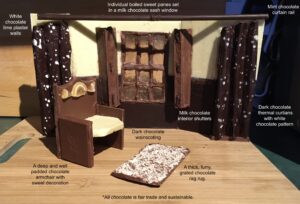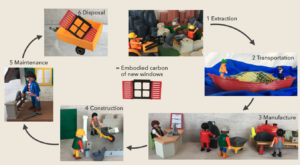My research is investigating ways to reduce carbon emissions from residential heritage buildings while retaining their heritage values.
It is generally acknowledged that many more buildings can be considered heritage buildings than merely those designated in planning as listed or in conservation areas. It is unclear how many buildings fall into the ‘heritage category’ but it could be 20-30% of the UK building stock, a fairly significant proportion!
They are frequently categorised as cold, damp, expensive, energy inefficient and a source of significant carbon emissions. They are considered to be ‘hard to treat buildings’ with limited potential to be ‘fixed’ because of the restrictions on retrofitting imposed by their heritage values, traditional, generally solid wall construction and different ways of managing moisture.
Attempts to retrofit these building have often led to unintended consequences such as moisture challenges, mould growth and loss of historic features while not achieving anywhere near the predicted carbon savings.
What’s going on?
Could it be that we are approaching ‘the problem’ in the wrong way? Is it, in fact, as much of a problem as assumed?
OK, older buildings do tend to be colder in winter, but they are also generally much more comfortable than modern buildings in summer [1]. Given the UK’s warming climate and the increasing demand for air conditioning in our modern super insulated boxes maybe this isn’t a bad trade off.
Secondly let’s look at the carbon emissions, the average UK household’s carbon emissions from building services (that’s space heating, hot water and lighting) is 6tonnes per year. Taking an un-reprentative illustrative sample of 7 heritage buildings in Cumbria -that’s right, the cold wet, north west corner where you’d think you’d need to use more energy- the actual average energy use is 5.2tonnes per year.
Oh, and that is based on total energy use so includes appliances and plug loads as well. The the average floor area is also 159m2 compared with 95m2 for the average UK home [2].
So, while I am in no way saying that we don’t need work to reduce carbon from these buildings, maybe they are not quite the ‘carbon villains’ [3] which they are commonly portrayed as and maybe we need to take a closer look at how these buildings are performing.
Holistic Approaches to carbon reduction from heritage buildings
Firstly it isn’t the buildings that are using all that energy and carbon…

…We need to look to the building occupiers and their needs and behaviours to understand energy use.
- And it turns out that people in heritage buildings generally have some positive behaviours here is a short list: Wearing jumpers and slippers. Personal insulation is extremely effective at keeping people warm and if your feet are warm the rest of you is likely to be ok as well. Do you really need to walk around in that T-shirt in December?
- Only heating parts of the house actually used.Why heat that spare bedroom that you only use when Aunt Mabel comes to visit? Back before the invention of central heating we all did this.
- No or minimal heat in bedrooms. That’s what duvets are for! Although some of the heritage building residents that I’ve spoken to have also recommended, electric blankets, partners and cats as good source of bed heating…
- Spot heating. This is in fact what a fire, portable heater or a hot water bottle is, bring the heat to where it is actually needed rather than letting it dissipate around the house.
These strategies are all part of an approach aimed at ‘keeping people rather than buildings warm’ [4]. Which when you think about it doesn’t actually seem like a bad idea, just as it’s the people rather than the buildings than use energy, so it’s the people that need to keep warm, not the building.

In fact, these strategies sound like pretty good sense for both comfort and environmental reasons and taking account of these sorts of behaviours is necessary when considering appropriate retrofits, something that often doesn’t happen when standard models (and funding) are focussed on fabric alterations like window replacement and wall insulation.
Which leads on to the next point, that we need to broaden the definition of retrofit to include behavioural and non-fabric interventions. Alterations that are not commonly included in retrofit considerations because they are deemed to be within the purview of ‘occupant choice.’ Fair enough, but occupants should be informed about the impact that their choices could have on energy use, for example, curtains!
Historic England have shown that adding thermal curtains to windows can reduce heat loss by 41% while the addition of internal shutters can reduce it by 58% [5]. These types of changes, along with good window refurbishment, can improve the U-value of single glazed sashes to a level comparable with modern double glazing. They are likely to have significantly less negative heritage impact than that new double glazing and therefore be more acceptable to residents who place significant value on their original windows.

They are likely to cost significantly less than new double glazing and when I say cost, I don’t mean only financial cost but environmental costs as well, bringing us on to the third element of our holistic heritage approach, lifecycle carbon.
Lifecycle carbon includes the energy and carbon required to make, transport and install a retrofit, as well as the saving is may make in use, it’s maintenance and end of life disposal [6]. This is broken up into operational carbon and embodied carbon and everyone always measures the embodied savings of retrofitting but often forgets to account for the embodied costs.

The lifecycle costs of retrofits should be considered to find out which retrofits are really the most environmentally friendly and to avoid unnecessary emissions. This is the next part of my research project so there aren’t any nice comparative numbers for you, but, personally, I’m betting on the curtains and shutters being significantly better than full window replacement on this metric.
Conclusions
So, for our holistic view of carbon reduction from heritage buildings we should:
- Consider user behaviour and encourage positive actions (slippers)
- Keep the aims of energy use firmly in mind, it’s for the people not the building (hot water bottles)
- Widen our perspective on retrofit to include non-fabric elements and things within the bounds of occupant choice (curtains)
- Consider all this within a lifecycle, not just and operational, carbon perspective. (embodied carbon)
What’s your best home energy saving behaviour or not fabric retrofit?
(by the way, any suggestions of a better name for ‘non-fabric retrofits’ would be very welcome as it doesn’t have much of a ring to it!).
Thanks for reading!
Reference List
1 Bateson, Ashley (2018) Residential design quality. Research report., Hoare Lea.
2 Piddington, Justine, Nicol, Simon, Garrett, Helen and Custard, Matthew (2020) The Housing Stock of the United Kingdom, Watford, BRE Trust.
3 Rye, Caroline (2015) ‘Are traditional buildings really carbon villains? Why it matters when insulating solid walls’. Journal of Building Survey, Appraisal & Valuation, 4(2), pp. 119–126.
4 Humphreys, Michael, Nicol, Fergus and Roaf, Susan (2011) Keeping warm in a cooler house, Historic Scotland.
5 Wood, Chris, Bordass, Bill and Baker, Paul (2009) RESEARCH INTO THE THERMAL PERFORMANCE OF TRADITIONAL WINDOWS: TIMBER SASH WINDOWS, English Heritage.
6 Wise, Freya (2020) ‘Embodied Carbon: Three Reasons we should care (Open Learn Article)’. Embodied Carbon: Three Reasons we should care. [online] Available from: https://www.open.edu/openlearn/nature-environment/environmental-studies/embodied-carbon-three-reasons-we-should-care (Accessed 4 December 2020)

Leave a Reply